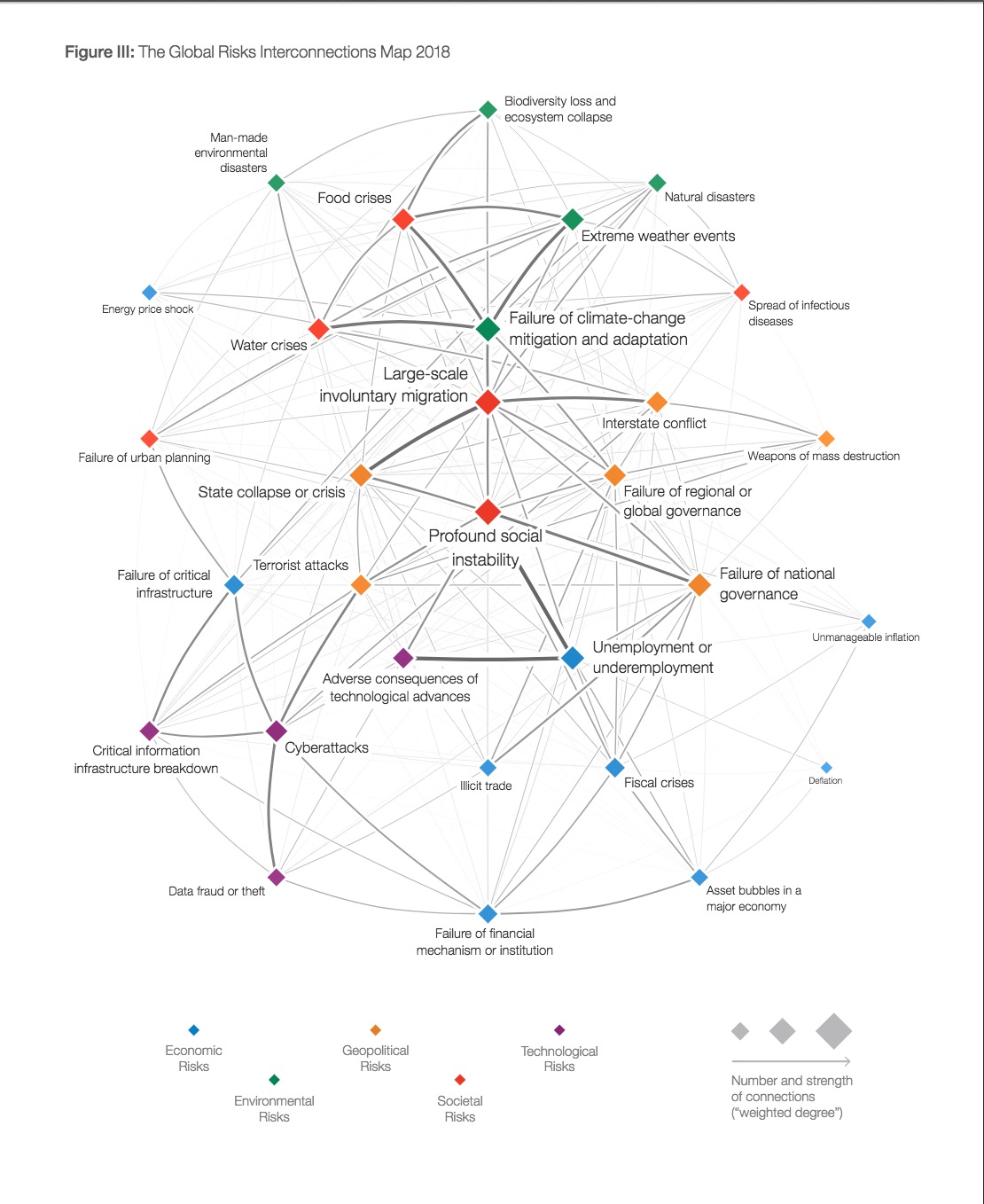 Our theme this month is ‘doing different’. But it pays to ask ‘Why’? – and what may be the consequences of not paying attention to this question.
Our theme this month is ‘doing different’. But it pays to ask ‘Why’? – and what may be the consequences of not paying attention to this question.
The human mind is hardwired for novelty. We seek out what is different and exciting. And it has served us well. It has been the source of our greatest inventions. But it can also lead us astray. When I left the University to work in the public service back in the early 1980s, every heavy engineering organisation (rail, ports, power, water, telecommunications) was headed up by an engineer – a guy (and they were all guys) who knew how to get things done. At this time, ‘stewardship’ was the word most accorded to those who ‘took care of’ assets, asset management was still in the future. But as the administration gradually moved from stewardship into management, we saw a different face at the top. And these different faces were finance and accounting. These guys (again!) knew what things cost. Under this leadership, we focussed on efficiency rather than effectiveness, or, in practice, ‘getting costs down’. This was when we introduced outsourcing, later to be followed by corporatisation and privatisation. The next move at the top was to ‘content free management’, these were people who were not engineers who knew how to get things done, and not finance who knew how much things cost, they were people trained in nothing more than ‘management’ itself. And now we started to see more female faces at the top. We also started to see something else. Whereas previous heads had worked to ‘keep the show on the road’, this new crop of managers were keen to ‘do something different’. The more radical the difference, the greater the publicity that they could expect. The publicity they garnered was sufficient to move them on to the next top job. Few stayed around longer than a few years to cope with the damage they caused.
We continue to exhalt difference for its own sake. ‘Disruptive’ is the joyful current buzzword. As if disruption itself was the benefit. How many times do you find new ideas presented at conferences – and how few are the times when those same presenters return a few years later to tell you honestly what the outcomes were? In fact, In our haste to move on to the next new and shiny thing, how much time and effort do we put in to make the last change succeed?
I still believe that we need to ‘do different’ – but not for its own sake!
My question today is: If not for its own sake – what IS the purpose of ‘doing different’?
This opens up a whole realm of possibilities for using environmental science and illustrates the importance of thinking of traditional infrastructure solutions as a ‘last resort’ rather than a first! This post is by Chris Adam, Director of Strategic AM Pty Ltd, Brisbane, Queensland
 Nitrogen (TN) creates problems in the ecosystem due to the tendency to create algal blooms that can disrupt the food chain. Thirty years ago point source loads (e.g. Sewerage Treatment Plants) were a problem. Who can forget the Sydney beaches of the 1980s when the wind turned onshore? Over the last 20 years we have made huge inroads into resolving these issues. More could be done but we are getting close to the top of the economically rational return to scale. So what ELSE can we do?
Nitrogen (TN) creates problems in the ecosystem due to the tendency to create algal blooms that can disrupt the food chain. Thirty years ago point source loads (e.g. Sewerage Treatment Plants) were a problem. Who can forget the Sydney beaches of the 1980s when the wind turned onshore? Over the last 20 years we have made huge inroads into resolving these issues. More could be done but we are getting close to the top of the economically rational return to scale. So what ELSE can we do?
Queensland Urban Utilities
Queensland Urban Utilities have piloted a couple of nutrient offset projects in which riverbank stabilisation and remediation (leading to a reduction in sediment runoff and therefore TN into the bay). These projects have performed really well (in fact, in the recent torrential rainfall from the tropical low that was once Cyclone Debbie, the sites not only stood up to the challenge but captured sediment!!).
Making a very long story short, the cost of these schemes seem to be in the order of $25,000 per tonne of TN. The current cost of treatment for all EXISTING Wastewater Treatment Plants is in the order of $13,000/Tonne (no surprises here – the return to scale of the existing network is the most cost effective option for removing nutrients). However the cost of augmentation of treatment plants starts at $50,000/tonne. So, what does this mean? We sweat the existing treatment plants (even overloading them hydraulically if necessary) as that’s the cheapest nutrient removal option. However, the next best option seems to be nutrient offsets through land remediation.
There are challenges here in that the regulator will currently only allow offsets against wet weather flow (this is based on the logic that the offset program only removes sediment during rain events which is an assumption that we could debate). The “least best” option is augmentation of the plants (i.e. “hard engineering” that locks in a centralised service model and ignores potential technical obsolescence of the plant itself).
The US EPA have gone further and have set up nutrient trading markets as a mechanism to manage/minimise TN discharge across point and non-point sources of pollution. A similar scheme has been in operation in Lake Taupo in NZ and there are schemes (in the early stages of development) being piloted for the Great Barrier Reef).
What this means is that the water services engineer of tomorrow will definitely have to think beyond the traditional “engineered” solution and understand the issues across a much broader range of inputs/outcomes. It’s very interesting times .
Thoughts?

Our post today – with thanks – builds on an idea by Rebecca Brown, Manager Waste & Recycling at WALGA, who will be presenting at the March WA State Conference of the IPWEA. (details below).
The first stage to ‘doing different’ is to imagine!
Rebecca says: “Imagine a road that is made from completely sustainable products and when it wears out will be used as the input into another road or project. All the materials will circle through the system again and again. This is the aim of the circular economy and the direction our State is going. Instead of the current linear economy model – dig, use, dispose, in the Circular Economy approach no materials go to waste, everything is an input into another process.
That may seem like an unattainable goal, given WA currently generates about 2 tonnes of waste per household/year, but for civil works this aim is completely achievable. Using old roads for new, using innovative materials and sourcing high quality construction and demolition materials all provide us with a way to move towards achieving a circular economy in WA.”
At the forthcoming WA State Conference of the IPWEA, “Rebecca Brown, Manager Waste & Recycling at WALGA will provide a brief overview of the Circular Economy approach and how it fits into the State Government’s new direction, provided by an updated State Waste Strategy. Drawing on lessons from over 10 years of experience using a range of recycled materials, Colin Leek, an industry expert, will share his experience and present case studies of how to use these materials to close the loop. Dave Markham, Chair of the Waste Management Association C&D Working Group will explain the processes in place to ensure that high quality process.”
The second stage to ‘doing different’ is to extend.
In other words to see if we can apply what we have learned in one situation – for example, as in the above, for renewing existing roads – to totally new situations.
Can we imagine a situation where, instead of accruing more and more roads, we are able to decommission an existing road in favour of a more relevant route – return the road to arable, residential, or park lands – and re-utilise the road materials in the new location?
What would it take to make this idea reality?
 A new month – and a new theme. This month we are looking at ways of ‘doing different’. To introduce this theme, what better than to use the Ted Talk presented in 2009 by adman Rory Sutherland (kindly drawn to my attention by Hein Aucamp, one of our regular contributors).
A new month – and a new theme. This month we are looking at ways of ‘doing different’. To introduce this theme, what better than to use the Ted Talk presented in 2009 by adman Rory Sutherland (kindly drawn to my attention by Hein Aucamp, one of our regular contributors).
In this talk Rory argues that the role of advertising is to create intangible value (or perceived, subjective, or ‘badge’ value). His opening story tells of a group of engineers who, some ten years previously, were asked how to improve the train trip from London to Paris. The engineers come up with a solution requiring the construction of new rail tracks to the coast, costing 6 billion, to cut 40 minutes off the then 3.5 hour travel time. Rory considered this a particularly unimaginative solution and presented his alternative – employ the world’s top male and female supermodels to walk up and down the train handing out free Château Pétrus. “You’ll still have about 3 billion in change, and people will ask for the trains to be slowed down!” In other words, we can improve the trip by making it more enjoyable rather than simply making it shorter. His whole TED talk, which you can find here, is a great example of this – so enjoyable, you wish it were longer! It is also full of ideas that may be used to help change focus and produce better results – by ‘doing different’.
So this month we are looking for examples of ‘doing different’
– examples that will improve outcomes (social, environmental and economic) by reducing the draw on scarce resources, a ‘less is more’ approach to infrastructure and construction. Your inspiring examples welcome. Please send them to me at penny@TalkingInfrastructure.com
And don’t forget that you can join in discussion on earlier blog posts.
The posts are designed as conversation starters. Show your appreciation by adding your perspective, your suggestions, your experience.
 For senior decision makers, infrastructure used to be a relatively simple matter – assign different teams of engineering and finance specialists to determine if it could be built and could be afforded. Infrastructure decision making is no longer simple, more a matter of juggling many factors, each of unknown severity and immediacy. This is why I have introduced the ‘big picture’ issues now being dealt with by the world’s financial elite at the World Economics Forum, and the many practical issues essential for economic, social and environmental sustainability, that the United Nations are grappling with in the 17 SDGs, the sustainable development goals.
For senior decision makers, infrastructure used to be a relatively simple matter – assign different teams of engineering and finance specialists to determine if it could be built and could be afforded. Infrastructure decision making is no longer simple, more a matter of juggling many factors, each of unknown severity and immediacy. This is why I have introduced the ‘big picture’ issues now being dealt with by the world’s financial elite at the World Economics Forum, and the many practical issues essential for economic, social and environmental sustainability, that the United Nations are grappling with in the 17 SDGs, the sustainable development goals.
Being aware of the issues is clearly the first step, but then what?
How would you go about including these goals in your own infrastructure decision making? And how would you know when you have been successful? The Australian Senate has recently launched an inquiry into the implementation of the SDGs. Here is what they are looking at. (Note that the last 4 line items refer to Australia’s work in supporting other nations.)
Questions for Today:
- Are they the right questions for the Senate? What is missing?
- Are they the right questions for You in your own infrastructure decision making? What questions would you add, or modify?
Here is the Senate Inquiry’s Terms of Reference
An inquiry into:
- the understanding and awareness of the SDG across the Australian Government and in the wider Australian community;
- the potential costs, benefits and opportunities for Australia in the domestic implementation of the SDG;
- what governance structures and accountability measures are required at the national, state and local levels of government to ensure an integrated approach to implementing the SDG that is both meaningful and achieves real outcomes;
- how can performance against the SDG be monitored and communicated in a way that engages government, businesses and the public, and allows effective review of Australia’s performance by civil society;
- what SDG are currently being addressed by Australia’s Official Development Assistance (ODA) program;
- which of the SDG is Australia best suited to achieving through our ODA program, and should Australia’s ODA be consolidated to focus on achieving core SDG;
- how countries in the Indo-Pacific are responding to implementing the SDG, and which of the SDG have been prioritised by countries receiving Australia’s ODA, and how these priorities could be incorporated into Australia’s ODA program; and
- examples of best practice in how other countries are implementing the SDG from which Australia could learn.
 Our January theme is ‘Getting Ready for Change’. One of the biggest changes is that infrastructure is no longer a national, but a global game.
Our January theme is ‘Getting Ready for Change’. One of the biggest changes is that infrastructure is no longer a national, but a global game.
In the last several posts we briefly looked at the issues being addressed at the World Economic Forum. But WEF is not Australia’s only major international commitment impacting our infrastructure decisions.
The Australian Government is also a signatory, along with over 190 other countries, to the United Nations 17 sustainable development goals, or SDGs. This requires the co-operation of all levels of government, all business and really all individual Australians. Yet how many of us are even aware of these goals?
The Senate has recently opened an inquiry into the implementation of the SDGs and we will look at this next few posts. But first, consider the goals themselves. Unlike the United Nations’ earlier Millenial Goals which focussed on developing countries, the SDGs apply to all, developing and developed alike.

One of the first steps is getting ready for change is to be aware of the global game we are now playing in.
So Three questions today:
- On an individual level: how many of the goals apply to consumption choices you make?
- On an organisational level: how many of the goals apply to the work your organisation does?
- On a government level: how many of the goals apply to the decisions our governments make (at all levels)?
If you would like to share your thoughts on these issues, please do – just click in the menu above the item ‘leave a comment’.
 ‘Experts’ have been taken to task for being ‘close focussed’, thinking only of their own area and not connecting with the wider world. If infrastructure decisions are to improve our world, they need to take in the wider context. How difficult this will be is, I think, indicated in the following statement of purpose for the World Economic Forum that begins this week in Davos.
‘Experts’ have been taken to task for being ‘close focussed’, thinking only of their own area and not connecting with the wider world. If infrastructure decisions are to improve our world, they need to take in the wider context. How difficult this will be is, I think, indicated in the following statement of purpose for the World Economic Forum that begins this week in Davos.
Creating a Shared Future in a Fractured World
“The global context has changed dramatically: geostrategic fissures have re-emerged on multiple fronts with wide-ranging political, economic and social consequences. Realpolitik is no longer just a relic of the Cold War. Economic prosperity and social cohesion are not one and the same. The global commons cannot protect or heal itself.
Politically, new and divisive narratives are transforming governance. Economically, policies are being formulated to preserve the benefits of global integration while limiting shared obligations such as sustainable development, inclusive growth and managing the Fourth Industrial Revolution. Socially, citizens yearn for responsive leadership; yet, a collective purpose remains elusive despite ever-expanding social networks. All the while, the social contract between states and their citizens continues to erode.
The 48th World Economic Forum Annual Meeting therefore aims to rededicate leaders from all walks of life to developing a shared narrative to improve the state of the world. The programme, initiatives and projects of the meeting are focused on Creating a Shared Future in a Fractured World. By coming together at the start of the year, we can shape the future by joining this unparalleled global effort in co-design, co-creation and collaboration. The programme’s depth and breadth make it a true summit of summits.”
 Next week Australia will join world leaders, big business and international institutions at the World Economic Forum in Davos. Ahead of this meeting WEF has released its Insight Report “The Global Risks Report 2018”. It is worth reading – and fascinating! This is the world for which we need to make future infrastructure decisions. Here is a glimpse.
Next week Australia will join world leaders, big business and international institutions at the World Economic Forum in Davos. Ahead of this meeting WEF has released its Insight Report “The Global Risks Report 2018”. It is worth reading – and fascinating! This is the world for which we need to make future infrastructure decisions. Here is a glimpse.
Also of interest for future planning is the section of the report that contains a chart showing how the risk profiles have changed year on year.
Thoughts?

Penny: We talk a lot about change today but as Chris Adam, Director of Strategic AM Pty Ltd, Brisbane, Qeensland, points out in this post, change has always been with us – and we have survived. But consider our reactions to the changes that have occurred within the last 100 years. Have we really done much better than just blunder through? And, can we do better now? Indeed, “how” do we ‘rethink the future’.

Do we just fight fires?
1. The Inevitability of Change
We need only reflect on the last century to recognise the inevitability of change:
- The second decade of the 20th century was defined by “the war to end all wars” which brought destruction and dislocation on a scale never before experienced
- The 1920s were a decade of social and economic change finishing with the most disruptive stock market crash of all time;
- The 1930s yielded the depression with further social and economic dislocation on a grand scale;
- The 1940s was defined by WWII with death, destruction and dislocation on a scale that dwarfed our previous efforts;
- The 1950s were a massive social and economic challenge as the world rebuilt and millions immigrated;
- The 1960s sexual revolution;
- The 1970s energy crises;
- The 1980s “greed is good” decade;
- The 1990s with the “dot com bubble”
My point is not to undermine the idea that current forces are not indeed a major challenge but to demonstrate that change is inevitable and, as a species, we have a proven capability to respond to such challenges
2. How do we “Re Think” the Future?
We tend to see change as a threat and prefer it didn’t occur, so how do we address this challenge and avoid a “head in the sand” attitude?
We need to take the future seriously but predicting the future is problematic. With the possible exception of WWII, practically no-one forecast the massive changes that characterised each decade of the 20th century. Current predictions that IT will lead to massive unemployment as machines take over reflect the exact same claims in the 1990s where it was forecast that traditional retail was “dead” as people would abandon shopping (as an inefficient and limited way to produce what we want and need).
3. So, if we can’t predict the future, how do we “take the future seriously”?
Ideas?
Penny: Today’s post is by Hein Aucamp, Director, WA Integrated Asset Management, and member of our Perth City Chapter, WA, He considers what infrastructure decision making today might gain from what he has learnt from years in the volatile area of Information Technology.
 I spent many years developing Engineering and mapping related software. Rapid change, which is becoming apparent in infrastructure, has always been a feature of Information Technology, where the knowledge half-life is said to be 2 years. I trust that Infrastructure Decision Making will never become as volatile as that but it will certainly be less stable than it has been in the past.
I spent many years developing Engineering and mapping related software. Rapid change, which is becoming apparent in infrastructure, has always been a feature of Information Technology, where the knowledge half-life is said to be 2 years. I trust that Infrastructure Decision Making will never become as volatile as that but it will certainly be less stable than it has been in the past.
Here are my suggestions of translatable lessons. One can cope much more easily with a volatile discipline by dividing it into two broad categories: first, timeless principles; second, current methods to achieve the timeless principles. We need to be able to distinguish between them, to hold tightly onto the timeless principles, and also to be lightly invested in what is temporarily useful.
Timeless Principles
To get our thinking started, I suggest that these are some of the timeless principles:
• Infrastructure must solve a human need. This sounds as if it is stating the obvious, but think about a situation where infrastructure solves a narrow need but creates a broader pernicious problem: environmental damage, economic hardship for generations, etc. The timeless principle here is a healthy understanding of the service needs we are trying to solve, and the trade-offs involved in our proposed solutions – and indeed a calculation about whether in some cases it would be better to live with the problems.
• Infrastructure creates a long-term responsibility, with unforeseen obligations that might emerge only over time – arising through legislation, reporting requirements, or safety issues. Think for example of the difficulties of managing asbestos, which was once very much in favour. Once built, society will tend to want to renew infrastructure.
• Infrastructure will always have a political aspect. Public infrastructure requires funding by governments and will be attractive during electioneering. Suggestion: an independent central banking system has immunised monetary policy from most aspects of political influence except commentary. Are some lessons for infrastructure possible here? I am of course not suggesting a command economy, but perhaps a broad consistent policy climate could be created – analogous to the way objective renewal programs are supposed to stop jockeying for resealing of roads for influential people.
Current Methods
On the other hand, here are some of the temporary, current methods at our disposal to deal with the timeless principles. We know they are capable of adjustment, because they have been adjusted in the past.
• Funding mechanisms.
• Contrasting promises during elections.
• Technology.
• Legislation.
• Best practices.
Comment?
Do you agree with this division? With the ‘timeless principles’?
How can we apply these lessons from Information Technology?
What other areas might we draw upon for valuable lessons?

Recent Comments